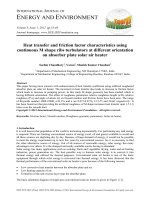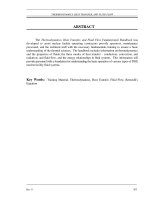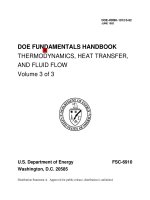- Trang chủ >>
- Khoa Học Tự Nhiên >>
- Vật lý
doe fundamentals handbook - thermodynamics, heat transfer, and fluid flow - volume 3 of 3
Bạn đang xem bản rút gọn của tài liệu. Xem và tải ngay bản đầy đủ của tài liệu tại đây (1.19 MB, 82 trang )
DOE-HDBK-1012/3-92
JUNE 1992
DOE FUNDAMENTALS HANDBOOK
THERMODYNAMICS, HEAT TRANSFER,
AND FLUID FLOW
Volume 3 of 3
U.S. Department of Energy FSC-6910
Washington, D.C. 20585
Distribution Statement A. Approved for public release; distribution is unlimited.
This document has been reproduced directly from the best available copy.
Available to DOE and DOE contractors from the Office of Scientific and Technical
Information. P. O. Box 62, Oak Ridge, TN 37831; prices available from (615) 576-
8401. FTS 626-8401.
Available to the public from the National Technical Information Service, U.S.
Department of Commerce, 5285 Port Royal Rd., Springfield, VA 22161.
Order No. DE92019791
THERMODYNAMICS, HEAT TRANSFER, AND FLUID FLOW
Rev. 0 HT
ABSTRACT
The Thermodynamics, Heat Transfer, and Fluid Flow Fundamentals Handbook was
developed to assist nuclear facility operating contractors provide operators, maintenance
personnel, and the technical staff with the necessary fundamentals training to ensure a basic
understanding of the thermal sciences. The handbook includes information on thermodynamics
and the properties of fluids; the three modes of heat transfer - conduction, convection, and
radiation; and fluid flow, and the energy relationships in fluid systems. This information will
provide personnel with a foundation for understanding the basic operation of various types of DOE
nuclear facility fluid systems.
Key Words: Training Material, Thermodynamics, Heat Transfer, Fluid Flow, Bernoulli's
Equation
THERMODYNAMICS, HEAT TRANSFER, AND FLUID FLOW
Rev. 0 HT
FOREWORD
The Department of Energy (DOE) Fundamentals Handbooks consist of ten academic
subjects, which include Mathematics; Classical Physics; Thermodynamics, Heat Transfer, and Fluid
Flow; Instrumentation and Control; Electrical Science; Material Science; Mechanical Science;
Chemistry; Engineering Symbology, Prints, and Drawings; and Nuclear Physics and Reactor
Theory. The handbooks are provided as an aid to DOE nuclear facility contractors.
These handbooks were first published as Reactor Operator Fundamentals Manuals in 1985
for use by DOE Category A reactors. The subject areas, subject matter content, and level of detail
of the Reactor Operator Fundamentals Manuals was determined from several sources. DOE
Category A reactor training managers determined which materials should be included, and served
as a primary reference in the initial development phase. Training guidelines from the commercial
nuclear power industry, results of job and task analyses, and independent input from contractors
and operations-oriented personnel were all considered and included to some degree in developing
the text material and learning objectives.
The DOE Fundamentals Handbooks represent the needs of various DOE nuclear facilities'
fundamentals training requirements. To increase their applicability to nonreactor nuclear facilities,
the Reactor Operator Fundamentals Manual learning objectives were distributed to the Nuclear
Facility Training Coordination Program Steering Committee for review and comment. To update
their reactor-specific content, DOE Category A reactor training managers also reviewed and
commented on the content. On the basis of feedback from these sources, information that applied
to two or more DOE nuclear facilities was considered generic and was included. The final draft
of each of these handbooks was then reviewed by these two groups. This approach has resulted
in revised modular handbooks that contain sufficient detail such that each facility may adjust the
content to fit their specific needs.
Each handbook contains an abstract, a foreword, an overview, learning objectives, and text
material, and is divided into modules so that content and order may be modified by individual DOE
contractors to suit their specific training needs. Each subject area is supported by a separate
examination bank with an answer key.
The DOE Fundamentals Handbooks have been prepared for the Assistant Secretary for
Nuclear Energy, Office of Nuclear Safety Policy and Standards, by the DOE Training Coordination
Program. This program is managed by EG&G Idaho, Inc.
THERMODYNAMICS, HEAT TRANSFER, AND FLUID FLOW
Rev. 0 HT
OVERVIEW
The Department of Energy Fundamentals Handbook entitled Thermodynamics, Heat
Transfer, and Fluid Flow was prepared as an information resource for personnel who are
responsible for the operation of the Department's nuclear facilities. A basic understanding of the
thermal sciences is necessary for DOE nuclear facility operators, maintenance personnel, and the
technical staff to safely operate and maintain the facility and facility support systems. The
information in the handbook is presented to provide a foundation for applying engineering
concepts to the job. This knowledge will help personnel more fully understand the impact that
their actions may have on the safe and reliable operation of facility components and systems.
The Thermodynamics, Heat Transfer, and Fluid Flow handbook consists of three modules
that are contained in three volumes. The following is a brief description of the information
presented in each module of the handbook.
Volume 1 of 3
Module 1 - Thermodynamics
This module explains the properties of fluids and how those properties are
affected by various processes. The module also explains how energy balances can
be performed on facility systems or components and how efficiency can be
calculated.
Volume 2 of 3
Module 2 - Heat Transfer
This module describes conduction, convection, and radiation heat transfer. The
module also explains how specific parameters can affect the rate of heat transfer.
Volume 3 of 3
Module 3 - Fluid Flow
This module describes the relationship between the different types of energy in a
fluid stream through the use of Bernoulli's equation. The module also discusses
the causes of head loss in fluid systems and what factors affect head loss.
THERMODYNAMICS, HEAT TRANSFER, AND FLUID FLOW
Rev. 0 HT
The information contained in this handbook is by no means all encompassing. An
attempt to present the entire subject of thermodynamics, heat transfer, and fluid flow would be
impractical. However, the Thermodynamics, Heat Transfer, and Fluid Flow handbook does
present enough information to provide the reader with a fundamental knowledge level sufficient
to understand the advanced theoretical concepts presented in other subject areas, and to better
understand basic system and equipment operations.
Department of Energy
Fundamentals Handbook
THERMODYNAMICS, HEAT TRANSFER,
AND FLUID FLOW,
Module 3
Fluid Flow
blank
Fluid Flow TABLE OF CONTENTS
TABLE OF CONTENTS
LIST OF FIGURES iv
LIST OF TABLES v
REFERENCES vi
OBJECTIVES vii
CONTINUITY EQUATION 1
Introduction 1
Properties of Fluids 2
Buoyancy 2
Compressibility 3
Relationship Between Depth and Pressure 3
Pascal’s Law 7
Control Volume 8
Volumetric Flow Rate 9
Mass Flow Rate 9
Conservation of Mass 10
Steady-State Flow 10
Continuity Equation 11
Summary 16
LAMINAR AND TURBULENT FLOW 17
Flow Regimes 17
Laminar Flow 17
Turbulent Flow 17
Flow Velocity Profiles 18
Average (Bulk) Velocity 19
Viscosity 19
Ideal Fluid 19
Reynolds Number 19
Summary 20
Rev. 0 Page i HT-03
TABLE OF CONTENTS Fluid Flow
TABLE OF CONTENTS (Cont.)
BERNOULLI’S EQUATION 21
General Energy Equation 21
Simplified Bernoulli Equation 22
Head 23
Energy Conversions in Fluid Systems 23
Restrictions on the Simplified Bernoulli Equation 25
Extended Bernoulli 25
Application of Bernoulli’s Equation to a Venturi 27
Summary 30
HEAD LOSS 31
Head Loss 31
Friction Factor 31
Darcy’s Equation 32
Minor Losses 34
Equivalent Piping Length 34
Summary 36
NATURAL CIRCULATION 37
Forced and Natural Circulation 37
Thermal Driving Head 37
Conditions Required for Natural Circulation 38
Example of Natural Circulation Cooling 39
Flow Rate and Temperature Difference 39
Summary 40
TWO-PHASE FLUID FLOW 41
Two-Phase Fluid Flow 41
Flow Instability 42
Pipe Whip 43
Water Hammer 43
Pressure spike 43
Steam Hammer 45
Operational Considerations 45
Summary 46
HT-03 Page ii Rev. 0
Fluid Flow TABLE OF CONTENTS
TABLE OF CONTENTS (Cont.)
CENTRIFUGAL PUMPS 47
Energy Conversion in a Centrifugal Pump 47
Operating Characteristics of a Centrifugal Pump 48
Cavitation 48
Net Positive Suction Head 49
Pump Laws 49
System Characteristic Curve 52
System Operating Point 52
System Use of Multiple Centrifugal Pumps 53
Centrifugal Pumps in Parallel 53
Centrifugal Pumps in Series 54
Summary 56
APPENDIX B Fluid Flow B-1
Rev. 0 Page iii HT-03
LIST OF FIGURES Fluid Flow
LIST OF FIGURES
Figure 1 Pressure Versus Depth 3
Figure 2 Pascal’s Law 7
Figure 3 Continuity Equation 12
Figure 4 "Y" Configuration for Example Problem 14
Figure 5 Laminar and Turbulent Flow Velocity Profiles 18
Figure 6 Venturi Meter 27
Figure 7 Typical Centrifugal Pump Characteristic Curve 48
Figure 8 Changing Speeds for Centrifugal Pump 51
Figure 9 Typical System Head Loss Curve 52
Figure 10 Operating Point for a Centrifugal Pump 52
Figure 11 Pump Characteristic Curve for Two Identical
Centrifugal Pumps Used in Parallel 53
Figure 12 Operating Point for Two Parallel Centrifugal Pumps 54
Figure 13 Pump Characteristic Curve for Two Identical
Centrifugal Pumps Used in Series 54
Figure 14 Operating Point for Two Centrifugal Pumps in Series 55
Figure B-1 Moody Chart B-1
HT-03 Page iv Rev. 0
Fluid Flow LIST OF TABLES
LIST OF TABLES
Table 1 Typical Values of 34
L
eq
D
Rev. 0 Page v HT-03
REFERENCES Fluid Flow
REFERENCES
Streeter, Victor L., Fluid Mechanics, 5th Edition, McGraw-Hill, New York,
ISBN 07-062191-9.
Knudsen, J. G. and Katz, D. L., Fluid Dynamics and Heat Transfer, McGraw-Hill, New
York.
McDonald, A. T. and Fox, R. W., Introduction to Fluid Mechanics, 2nd Edition, John
Wiley and Sons, New York, ISBN 0-471-98440-X.
Crane Company, Flow of Fluids Through Valves, Fittings, and Pipe, Crane Co. Technical
Paper No. 410, Chicago, Illinois, 1957.
Esposito, Anthony, Fluid Power with Applications, Prentice-Hall, Inc., New Jersey, ISBN
0-13-322701-4.
Wallis, Graham, One-Dimensional Two-Phase Flow, McGraw-Hill, New York, 1969.
Academic Program for Nuclear Power Plant Personnel, Volume III and IV,
General Physics Corporation, Library of Congress Card #A 397747, June 1982 and
April 1982.
HT-03 Page vi Rev. 0
Fluid Flow OBJECTIVES
TERMINAL OBJECTIVE
1.0 Given conditions affecting the fluid flow in a system, EVALUATE the effects on
the operation of the system.
ENABLING OBJECTIVES
1.1 DESCRIBE how the density of a fluid varies with temperature.
1.2 DEFINE the term buoyancy.
1.3 DESCRIBE the relationship between the pressure in a fluid column and the density and
depth of the fluid.
1.4 STATE Pascal’s Law.
1.5 DEFINE the terms mass flow rate and volumetric flow rate.
1.6 CALCULATE either the mass flow rate or the volumetric flow rate for a fluid system.
1.7 STATE the principle of conservation of mass.
1.8 CALCULATE the fluid velocity or flow rate in a specified fluid system using the
continuity equation.
1.9 DESCRIBE the characteristics and flow velocity profiles of laminar flow and turbulent
flow.
1.10 DEFINE the property of viscosity.
1.11 DESCRIBE how the viscosity of a fluid varies with temperature.
1.12 DESCRIBE the characteristics of an ideal fluid.
1.13 DESCRIBE the relationship between the Reynolds number and the degree of turbulence
of the flow.
1.14 DESCRIBE the relationship between Bernoulli’s equation and the First Law of
Thermodynamics.
Rev. 0 Page vii HT-03
OBJECTIVES Fluid Flow
ENABLING OBJECTIVES (Cont.)
1.15 DEFINE the term head with respect to its use in fluid flow.
1.16 EXPLAIN the energy conversions that take place in a fluid system between the velocity,
elevation, and pressure heads as flow continues through a piping system.
1.17 Given the initial and final conditions of the system, CALCULATE the unknown fluid
properties using the simplified Bernoulli equation.
1.18 DESCRIBE the restrictions applied to Bernoulli’s equation when presented in its simplest
form.
1.19 EXPLAIN how to extend the Bernoulli equation to more general applications.
1.20 RELATE Bernoulli’s principle to the operation of a venturi.
1.21 DEFINE the terms head loss, frictional loss, and minor losses.
1.22 DETERMINE friction factors for various flow situations using the Moody chart.
1.23 CALCULATE the head loss in a fluid system due to frictional losses using Darcy’s
equation.
1.24 CALCULATE the equivalent length of pipe that would cause the same head loss as the
minor losses that occur in individual components.
1.25 DEFINE natural circulation and forced circulation.
1.26 DEFINE thermal driving head.
1.27 DESCRIBE the conditions necessary for natural circulation to exist.
1.28 EXPLAIN the relationship between flow rate and temperature difference in natural
circulation flow.
1.29 DESCRIBE how the operator can determine whether natural circulation exists in the
reactor coolant system and other heat removal systems.
1.30 DESCRIBE how to enhance natural circulation flow.
1.31 DEFINE two-phase flow.
HT-03 Page viii Rev. 0
Fluid Flow OBJECTIVES
ENABLING OBJECTIVES (Cont.)
1.32 DESCRIBE two-phase flow including such phenomena as bubbly, slug, and annular flow.
1.33 DESCRIBE the problems associated with core flow oscillations and flow instability.
1.34 DESCRIBE the conditions that could lead to core flow oscillation and instability.
1.35 DESCRIBE the phenomenon of pipe whip.
1.36 DESCRIBE the phenomenon of water hammer.
1.37 DEFINE the terms net positive suction head and cavitation.
1.38 CALCULATE the new volumetric flow rate, head, or power for a variable speed
centrifugal pump using the pump laws.
1.39 DESCRIBE the effect on system flow and pump head for the following changes:
a. Changing pump speeds
b. Adding pumps in parallel
c. Adding pumps in series
Rev. 0 Page ix HT-03
Fluid Flow
Intentionally Left Blank
HT-03 Page x Rev. 0
Fluid Flow CONTINUITY EQUATION
CONTINUITY EQUATION
Understanding the quantities measured by the volumetric flow rate
and mass flow rate is crucial to understanding other fluid flow topics.
The continuity equation expresses the relationship between mass flow
rates at different points in a fluid system under steady-state flow
conditions.
EO 1.1 DESCRIBE how the density of a fluid varies with temperature.
EO 1.2 DEFINE the term buoyancy.
EO 1.3 DESCRIBE the relationship between the pressure in a
fluid column and the density and depth of the fluid.
EO 1.4 STATE Pascal’s Law.
EO 1.5 DEFINE the terms mass flow rate and volumetric flow
rate.
EO 1.6 CALCULATE either the mass flow rate or the
volumetric flow rate for a fluid system.
EO 1.7 STATE the principle of conservation of mass.
EO 1.8 CALCULATE the fluid velocity or flow rate in a
specified fluid system using the continuity equation.
Introduction
Fluid flow is an important part of most industrial processes; especially those involving the
transfer of heat. Frequently, when it is desired to remove heat from the point at which it is
generated, some type of fluid is involved in the heat transfer process. Examples of this are the
cooling water circulated through a gasoline or diesel engine, the air flow past the windings of
a motor, and the flow of water through the core of a nuclear reactor. Fluid flow systems are also
commonly used to provide lubrication.
Fluid flow in the nuclear field can be complex and is not always subject to rigorous mathematical
analysis. Unlike solids, the particles of fluids move through piping and components at different
velocities and are often subjected to different accelerations.
Rev. 0 Page 1 HT-03
CONTINUITY EQUATION Fluid Flow
Even though a detailed analysis of fluid flow can be extremely difficult, the basic concepts
involved in fluid flow problems are fairly straightforward. These basic concepts can be applied
in solving fluid flow problems through the use of simplifying assumptions and average values,
where appropriate. Even though this type of analysis would not be sufficient in the engineering
design of systems, it is very useful in understanding the operation of systems and predicting the
approximate response of fluid systems to changes in operating parameters.
The basic principles of fluid flow include three concepts or principles; the first two of which the
student has been exposed to in previous manuals. The first is the principle of momentum
(leading to equations of fluid forces) which was covered in the manual on Classical Physics. The
second is the conservation of energy (leading to the First Law of Thermodynamics) which was
studied in thermodynamics. The third is the conservation of mass (leading to the continuity
equation) which will be explained in this module.
Properties of Fluids
A fluid is any substance which flows because its particles are not rigidly attached to one another.
This includes liquids, gases and even some materials which are normally considered solids, such
as glass. Essentially, fluids are materials which have no repeating crystalline structure.
Several properties of fluids were discussed in the Thermodynamics section of this text. These
included temperature, pressure, mass, specific volume and density. Temperature was defined as
the relative measure of how hot or cold a material is. It can be used to predict the direction that
heat will be transferred. Pressure was defined as the force per unit area. Common units for
pressure are pounds force per square inch (psi). Mass was defined as the quantity of matter
contained in a body and is to be distinguished from weight, which is measured by the pull of
gravity on a body. The specific volume of a substance is the volume per unit mass of the
substance. Typical units are ft
3
/lbm. Density, on the other hand, is the mass of a substance per
unit volume. Typical units are lbm/ft
3
. Density and specific volume are the inverse of one
another. Both density and specific volume are dependant on the temperature and somewhat on
the pressure of the fluid. As the temperature of the fluid increases, the density decreases and the
specific volume increases. Since liquids are considered incompressible, an increase in pressure
will result in no change in density or specific volume of the liquid. In actuality, liquids can be
slightly compressed at high pressures, resulting in a slight increase in density and a slight
decrease in specific volume of the liquid.
Buoyancy
Buoyancy is defined as the tendency of a body to float or rise when submerged in a fluid. We
all have had numerous opportunities of observing the buoyant effects of a liquid. When we go
swimming, our bodies are held up almost entirely by the water. Wood, ice, and cork float on
water. When we lift a rock from a stream bed, it suddenly seems heavier on emerging from the
water. Boats rely on this buoyant force to stay afloat. The amount of this buoyant effect was
first computed and stated by the Greek philosopher Archimedes. When a body is placed in a
fluid, it is buoyed up by a force equal to the weight of the water that it displaces.
HT-03 Page 2 Rev. 0
Fluid Flow CONTINUITY EQUATION
If a body weighs more than the liquid it displaces, it sinks but will appear to lose an amount of
weight equal to that of the displaced liquid, as our rock. If the body weighs less than that of the
displaced liquid, the body will rise to the surface eventually floating at such a depth that will
displace a volume of liquid whose weight will just equal its own weight. A floating body
displaces its own weight of the fluid in which it floats.
Compressibility
Compressibility is the measure of the change in volume a substance undergoes when a pressure
is exerted on the substance. Liquids are generally considered to be incompressible. For instance,
a pressure of 16,400 psig will cause a given volume of water to decrease by only 5% from its
volume at atmospheric pressure. Gases on the other hand, are very compressible. The volume
of a gas can be readily changed by exerting an external pressure on the gas
Relationship Between Depth and Pressure
Anyone who dives under the surface of the water notices that the pressure on his eardrums at a
depth of even a few feet is noticeably greater than atmospheric pressure. Careful measurements
show that the pressure of a liquid is directly proportional to the depth, and for a given depth the
liquid exerts the same pressure in all directions.
Figure 1 Pressure Versus Depth
Rev. 0 Page 3 HT-03









